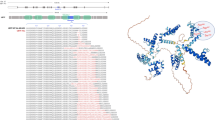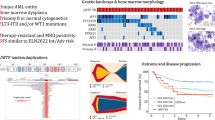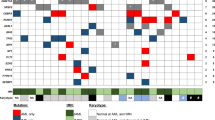Abstract
The frequency of acute leukemia in children with constitutional DNA repair defects implicates defective DNA repair in leukemogenesis. Whether sporadic cases of AML also arise from an inherited genetic predisposition remains to be determined. Prior studies have reported microsatellite instability (MSI) in AML, particularly secondary and relapsed AML. These studies included small numbers of cases in which key features such as cytogenetic abnormalities were not reported. To determine whether defective DNA mismatch repair, reflected by MSI, is a defining feature of adult myeloid leukemogenesis, we retrospectively studied 132 AML cases including 28 de novo, 62 secondary, 22 relapsed/refractory, 15 cases of paired diagnosis/relapse. 110 patients were elderly (55+ years). The cases included a range of cytogenetic abnormalities. MSI was assessed at three loci (BAT 25, BAT 26, BAT 40) in DNA isolated from sorted leukemic blasts and paired T cell controls. Fluoresceinated PCR products were analyzed using an automated capillary electrophoresis system. Of the 132 AML cases, no single case demonstrated MSI. Our studies indicate that MSI, and defective DNA mismatch repair, is not a defining feature of the majority of adult patients with AML. Furthermore, our data does not support the hypothesis that MSI could be acquired during the progression of AML from diagnosis to relapse, as a consequence of therapeutic exposure.
This is a preview of subscription content, access via your institution
Access options
Subscribe to this journal
Receive 12 print issues and online access
$259.00 per year
only $21.58 per issue
Buy this article
- Purchase on Springer Link
- Instant access to full article PDF
Prices may be subject to local taxes which are calculated during checkout



Similar content being viewed by others
References
Horwitz M, Benson K, Li F, Wolff J, Leppert M, Hobson L, Mangelsdorf M, Yu S, Hewett D, Richards R, Raskind W . Genetic heterogeneity in familial acute myelogenous leukemia: evidence for a second locus at chromosome 16q21–23.2 Am J Hum Genet 1997 61: 873–881
Ho C, Otterud B, Legare R, Varvil T, Saxena R, DeHart D, Kohler S, Aster J, Dowton S, Li F, Leppert M, Gilliland D . Linkage of a familial platelet disorder with a propensity to develop myeloid malignancies to human chromosome 21q22.1–22.2 Blood 1996 87: 5218–5224
Lynch HT, Smyrk T, Lynch J . An update of HNPCC (Lynch syndrome) Cancer Genet Cytogen 1997 93: 84–99
Aaltonen LA et al. Clues to the pathogenesis of familial colorectal cancer Science 1993 260: 812–816
Thibodeau SN, Bren G, Schald D . Microsatellite instability in cancer of the proximal colon Science 1993 260: 816–819
Fishel R, Lescoe M, Rao M, Copeland N, Jenkins N, Garber J, Kane M, Kolodner R . The human mutator gene homolog MSH2 and its association with hereditary nonpolyposis colon cancer Cell 1993 75: 1027–1038
Dietmaier W, Wallinger S, Bocker T, Kullmann F, Fishel R, Ruschoff J . Diagnostic microsatellite instability: definition and correlation with mismatch repair protein expression Cancer Res 1997 57: 4749–4756
Gaidano G, Pastore C, Gloghini A, Capello D, Tirelli U, Saglio G, Carbone A . Microsatellite instability in KSHV/HHV-8 positive body-cavity-based lymphoma Hum Pathol 1997 28: 748–750
Lowsky R, DeCoteau JF, Reitmair AH, Ichinohasama R, Dong W-F, Xu Y, Mak TW, Kadin ME, Minden MD . Defects of the mismatch repair gene MSH2 are implicated in the development of murine and human lymphoblastic lymphomas and are associated with the aberrant expression of rhombotin-2 (Lmo-2) and Tal-1 (SCL) Blood 1997 89: 2276–2282
Pabst T, Schwaller J, Jotterand Bellomo M, Oestreicher M, Muhlematter D, Tichelli A, Tobler A, Fey MF . Frequent clonal loss of heterozygosity but scarcity of microsatellite instability at chromosomal breakpoint cluster regions in adult leukemias Blood 1996 88: 1026–1034
Gartenhaus R, Johns III MM, Wang P, Rai K, Sidransky D . Mutator phenotype in a subset of chronic lymphocytic leukemia Blood 1996 87: 38–41
Tasaka T, Lee S, Spira S, Takeuchi S, Nagai M, Takahara J, Koeffler HP . Microsatellite instability during the progression of acute myelocytic leukemia Br J Haematol 1997 98: 219–221
Wada C, Shionoya S, Fujino Y, Tokuhiro H, Akahoshi T, Uchida T, Ohtani H . Genomic instability of microsatellite repeats and its association with the evolution of chronic myelogenous leukemia Blood 1994 83: 3449–3456
Silly H, Chase A, Mills KI, Apfelbeck U, Sormann S, Goldman JM, Cross NCP . No evidence for microsatellite instability or consistent loss of heterozygosity at selected loci in chronic myeloid leukaemia blast crisis Leukemia 1994 8: 1923–1928
Ohyashiki JH, Ohyashiki K, Aizawa S, Kawakubo K, Shimamoto T, Iwama H, Hayashi S, Toyama K . Replication errors in hematological neoplasias: genomic instability in progression of disease is different among different types of leukemia Clin Cancer Res 1996 2: 1583–1589
Indracollo S, Simon M, Hehlmann R, Erfle V, Chieco-Bianchi L, Leib-Moesch C . Genetic instability of a dinucleotide repeat-rich regions in three hematologic malignancies Leukemia 1995 9: 1517–1522
Robledo M, Martinez B, Arranz E, Trujillo M, Gonzalez Ageitos A, Rivas C, Benitez J . Genetic instability of microsatellites in hematological neoplasms Leukemia 1995 9: 960–964
Sill H, Goldman J, Cross N . Rarity of microsatellite alterations in acute myeloid leukemia Br J Cancer 1996 74: 255–257
Tasaka T, Lee S, Spira S, Takeuchi S, Hatta Y, Nagai M, Takahara J . Infrequent microsatellite instability during the evolution of myelodysplastic syndrome to acute myelocytic leukemia Leukemia Res 1996 20: 113–117
Boyer J, Risinger J, Farber R . Stability of microsatellites in myeloid neoplasias Cancer Genet Cytogenet 1998 106: 54–61
Ben-Yehuda D, Krichevsky S, Caspi O, Rund D, Polliack A, Abeliovich D, Zelig O, Yahalom V, Paltiel O, Or R, Peretz T, Ben-Neriah S, Yehuda O, Rachmilewitz EA . Microsatellite instability and p53 mutations in therapy-related leukemia suggest mutator phenotype Blood 1996 88: 4296–4303
Godwin J, Kopecky K, Head D, Willman C, Leith C, Hynes H, Balcerzak S, Applebaum F . A double-blind placebo-controlled trial of granulocyte colony-stimulating factor in elderly patients with previously untreated acute myeloid leukemia: a Southwest Oncology Group study (9031) Blood 1998 91: 3607–3615
Leith CP, Kopecky KJ, Godwin J, McConnell T, Slovak ML, Chen I-M, Head DR, Appelbaum F, Willman CL . Acute myeloid leukemia in the elderly: assessment of multidrug resistance (MDR1) and cytogenetics distinguishes biologic subgroups with remarkably distinct responses to standard chemotherapy. A Southwest Oncology Group study Blood 1997 89: 3323–3329
Parsons R, Li G-M, Longley M, Modrich P, Liu B, Berk T, Hamilton SR, Kinzler K, Vogelstein B . Mismatch repair deficiency in phenotypically normal human cells Science 1995 268: 738–740
Abrahamson G, Boultwood J, Madden J, Kelly S, Oscier DG, Rack K, Buckle VJ, Wainscoat JS . Clonality of cell populations in refractory anaemia using combined approach of gene loss and X-linked restriction fragment length polymorphism-methylation analyses Br J Haematol 1991 79: 550–555
Culligan DJ, Cachia P, Whittaker J, Jacobs A, Padua RA . Clonal lymphocytes are detectable in only some cases of MDS Br J Haematol 1992 81: 346–352
van Kamp H, Fibbe WE, Jansen RPM, van der Keur M, de Graaff E, Willemze R, Landegent JE . Clonal involvement of granulocytes and monocytes, but not of T and B lymphocytes and natural killer cells in patients with myelodysplasia: analysis by X-linked restriction fragment length polymorphisms and polymerase chain reaction of the phosphoglycerate kinase gene Blood 1992 80: 1774–1780
Tefferi A, Thibodeau SN, Solberg Jr LA . Clonal studies in the myelodysplastic syndrome using X-linked restriction fragment length polymorphisms Blood 1990 75: 1770–1773
Janssen JWG, Buschle M, Layton M, Drexler HG, Lyons J, van den Berghe H, Heimpel H, Kubanek B, Kleihauer E, Mufti GJ, Bartram CR . Clonal analysis of myelodysplastic syndromes: evidence of multipotent stem cell origin Blood 1989 73: 248–254
Tsukamoto N, Morita K, Maehara T, Okamoto K, Karasawa M, Omine M, Naruse T . Clonality in myelodysplastic syndromes: demonstration of pluripotent stem cell origin using X-linked restriction fragment length polymorphisms Br J Haematol 1992 83: 589–594
Champion KM, Gilbert JGR, Asimakopoulos FA, Hinshelwood S, Green AR . Clonal haemopoiesis in normal elderly women: implications for the myeloproliferative disorders and myelodysplastic syndromes Br J Haematol 1997 97: 920–926
Busque L, Mio R, Mattioli J, Brais E, Blais N, Lalonde Y, Maragh M, Gilliland DG . Nonrandom X-inactivation patterns in normal females: lyonization ratios vary with age Blood 1996 88: 59–65
Hauge XY, Litt M . A study of the origin of ‘shadow bands’ seen when typing dinucleotide repeat polymorphisms by the PCR Hum Mol Genet 1993 2: 411–415
Toh Y, Oki E, Oda S, Tomoda M, Tomisaki S, Ichiyoshi Y, Ohno S, Sugimachi K . An integrated microsatellite length analysis using an automated fluorescent DNA sequencer Cancer Res 1996 56: 2688–2691
Cawkwell L, Li D, Lewis FA, Martin I, Dixon MF . Microsatellite instability in colorectal cancer: improved assessment using fluorescent polymerase chain reaction Gastroenterology 1995 109: 465–471
Kaneko H, Horiike S, Inazawa J, Nakai H, Misawa S . Microsatellite instability is an early genetic event in myelodysplastic syndrome Blood 1995 86: 1236–1237
Orazi A, Cattoretti G, Heerema N, Sozzi G, John K, Neiman R . Frequent p53 overexpression in therapy related myelodysplastic syndromes and acute myeloid leukemias: an immunohistochemical study of bone marrow biopsies Mod Pathol 1993 6: 521–525
Kitagawa M, Yoshida S, Kuwata T, Tanizawa T, Kamiyama R . p53 expression in myeloid cells of myelodysplastic syndromes. Association with evolution of overt leukemia Am J Pathol 1994 145: 338–344
Jonveaux P, Fenaux P, Quiquandon J, Pignon J, Lai J, Loucheux-Lefebvre M, Goossens M, Buaters F, Berger R . Mutations in the p53 gene in myelodysplastic syndromes Oncogene 1991 6: 2243–2247
Lepelley P, Preudhomme C, Vanrumbeke M, Quesnel B, Cosson A, Fenaux P . Detection of p53 mutations in hematological malignancies: comparison between immunocytochemistry and DNA analysis Leukemia 1994 8: 1342–1349
Sugimoto K, Hirano N, Toyshima H, Chiba S, Mano H, Takaku F, Yazaki Y, Hirai H . Mutations of the p53 gene in myelodysplastic syndrome (MDS) and MDS-derived leukemia Blood 1993 8: 3022–3026
Ludwig L, Schulz A, Janssen J, Grunewald K, Bartram C . P53 mutations in myelodysplastic syndromes Leukemia 1992 6: 1302–1304
Cahill DP, Lengauer C, Yu J, Riggins GJ, Willson KKV, Markowitz SD, Kinzler KW, Vogelstein B . Mutations of mitotic checkpoint genes in human cancers Nature 1998 392: 300–303
Acknowledgements
Financial support provided by: DHHS NIH NCI CA 32102, CA33572 and CA30206 supporting the SWOG Leukemia Biology and Cytogenetics Programs and the State of New Mexico Dedicated Health Research Fund.
Author information
Authors and Affiliations
Rights and permissions
About this article
Cite this article
Rimsza, L., Kopecky, K., Ruschulte, J. et al. Microsatellite instability is not a defining genetic feature of acute myeloid leukemogenesis in adults: results of a retrospective study of 132 patients and review of the literature. Leukemia 14, 1044–1051 (2000). https://doi.org/10.1038/sj.leu.2401699
Received:
Accepted:
Published:
Issue Date:
DOI: https://doi.org/10.1038/sj.leu.2401699
Keywords
This article is cited by
-
Looking beyond the cytogenetics in haematological malignancies: decoding the role of tandem repeats in DNA repair genes
Molecular Biology Reports (2022)
-
No evidence for microsatellite instability in acute myeloid leukemia
Leukemia (2017)
-
DNA damage accumulation and repair defects in acute myeloid leukemia: implications for pathogenesis, disease progression, and chemotherapy resistance
Chromosoma (2014)
-
Azathioprine-Induced Microsatellite Instability Is Not Observed in Skin Carcinomas of Organ Transplant Recipients
Journal of Investigative Dermatology (2009)
-
Preferential loss of mismatch repair function in refractory and relapsed acute myeloid leukemia: potential contribution to AML progression
Cell Research (2008)



